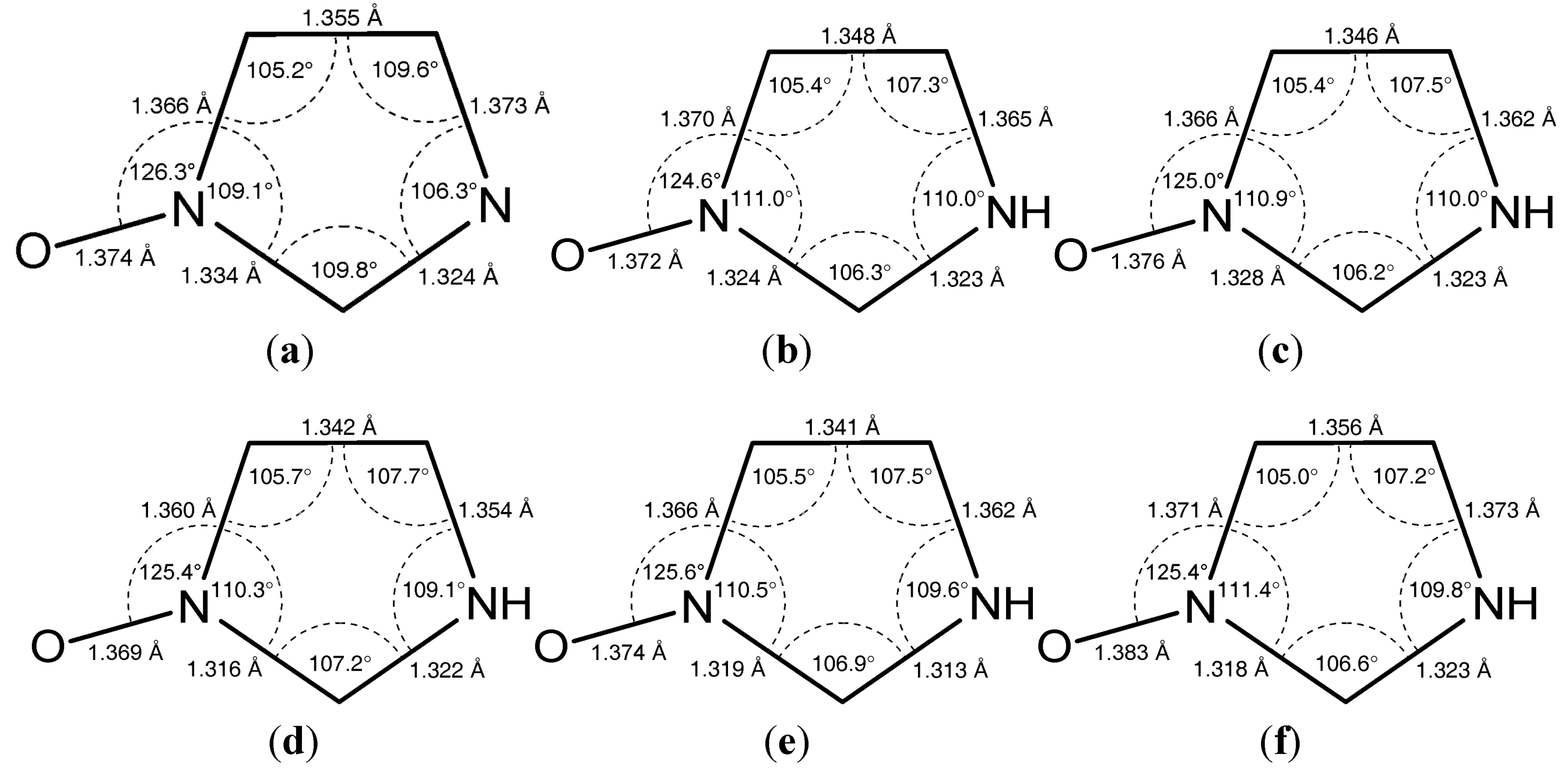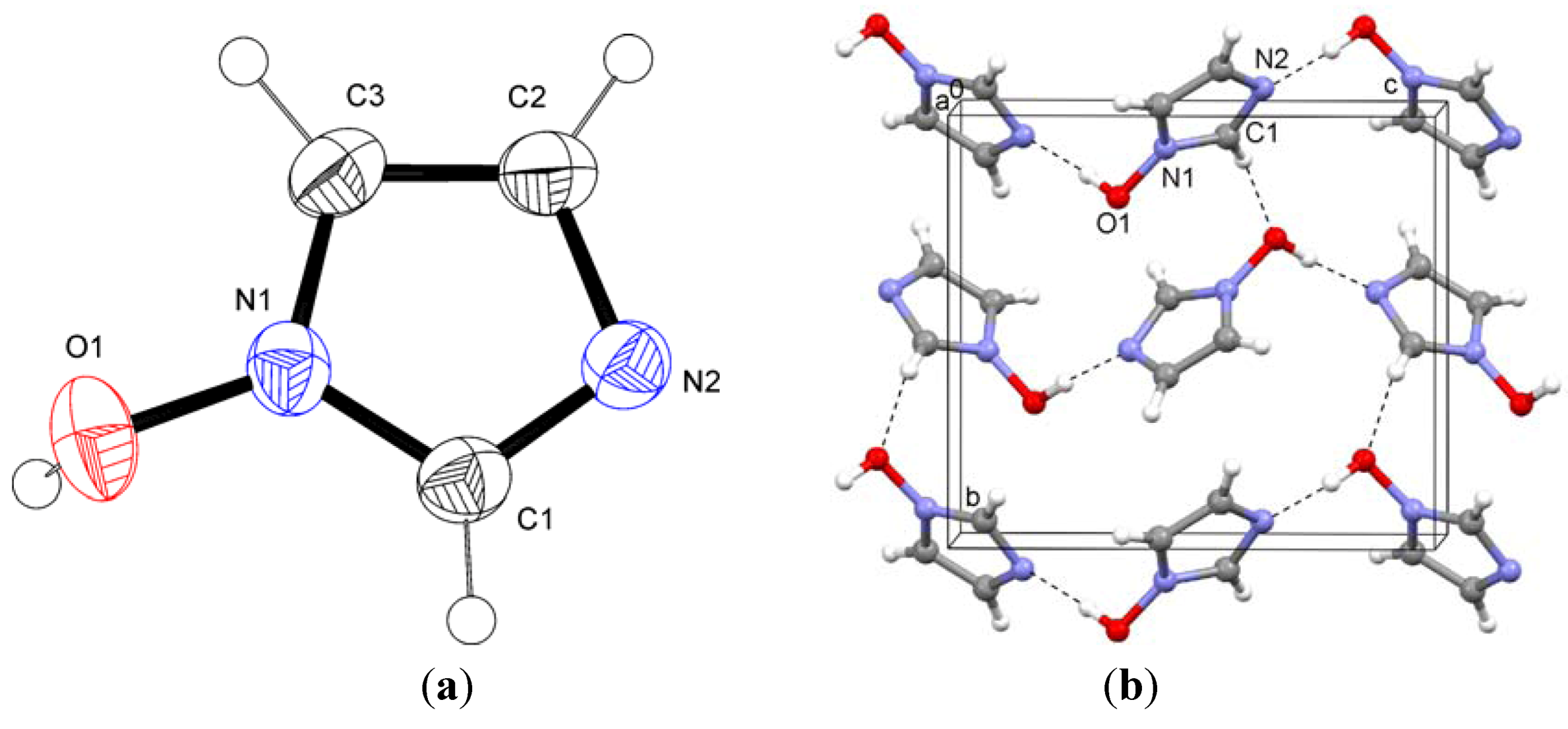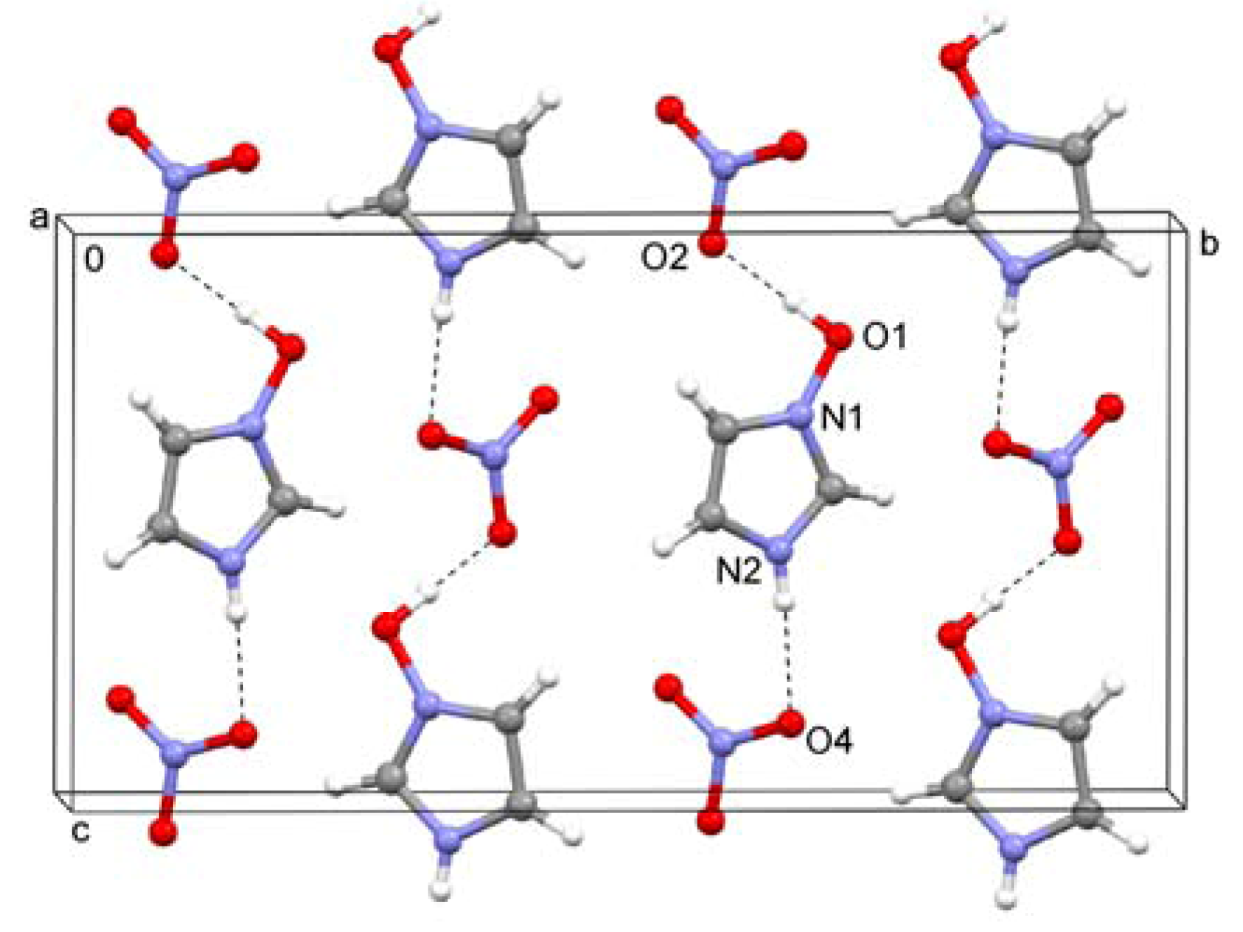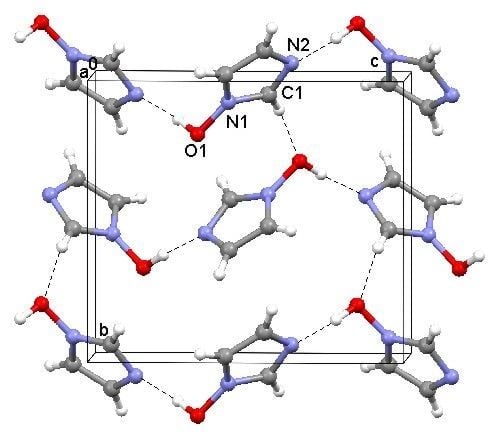Crystal Structures of 1-Hydroxyimidazole and Its Salts
Abstract
:1. Introduction
2. Results and Discussion
| Compound | 1 | 2 | 3 | 4 | 5 |
|---|---|---|---|---|---|
| CCDC no. | 899,476 | 899,477 | 899,478 | 899,479 | 899,480 |
| Chemical formula | C3H4N2O | C3H5N2O·Cl | C3H5N2O·Br | 2(C3H5N2O)·O4S | C3H5N2O·NO3 |
| Mr | 84.08 | 120.54 | 164.99 | 266.24 | 147.10 |
| Crystal size/mm3 | 0.40 × 0.20 × 0.16 | 0.32 × 0.30 × 0.16 | 0.26 × 0.20 × 0.20 | 0.48 × 0.28 × 0.28 | 0.23 × 0.11 × 0.11 |
| Crystal system | Orthorhombic | Monoclinic | Monoclinic | Triclinic | Monoclinic |
| Space group | P212121 | P21/n | P21/n |  | Cc |
| a/Å | 5.1024(3) | 4.2693(2) | 4.4182(2) | 6.5611(10) | 3.6216(6) |
| b/Å | 8.2922(5) | 10.7541(4) | 11.0416(6) | 7.7322(11) | 17.385(3) |
| c/Å | 9.3064(6) | 10.9756(4) | 11.2015(6) | 12.1134(14) | 9.0259(13) |
| α/° | 90 | 90 | 90 | 97.820(11) | 90 |
| β/° | 90 | 93.535(3) | 94.081(4) | 91.912(11) | 90.499(13) |
| γ/° | 90 | 90 | 90 | 113.295(14) | 90 |
| V/Å3 | 393.75(4) | 502.96(4) | 545.07(5) | 556.62(13) | 568.26(16) |
| Z | 4 | 4 | 4 | 2 | 4 |
| Dx/g·cm−3 | 1.42 | 1.59 | 2.01 | 1.59 | 1.72 |
| μ/mm−1 | 0.94 | 0.63 | 7.42 | 0.32 | 1.41 |
| F(000)/e | 176 | 248 | 320 | 276 | 304 |
| Radiation | Cu Kα | Mo Kα | Mo Kα | Mo Kα | Cu Kα |
| θmax/° | 67.4 | 25.4 | 25.3 | 25.4 | 67.6 |
| h, k, l range | −6 ≤ h ≤ 6 | −5 ≤ h ≤ 3 | −5 ≤ h ≤ 5 | −6 ≤ h ≤ 7 | −4 ≤ h ≤ 4 |
| −9 ≤ k ≤ 8 | −12 ≤ k ≤ 12 | −13 ≤ k ≤ 10 | −8 ≤ k ≤ 9 | −17 ≤ k ≤ 20 | |
| −11 ≤ l ≤ 11 | −11 ≤ l ≤ 13 | −13 ≤ k ≤ 12 | −12 ≤ l ≤ 14 | −10 ≤ k ≤ 10 | |
| Measured reflections | 2571 | 2909 | 3152 | 3377 | 1946 |
| Independent reflections ( Rint) | 690(0.024) | 915(0.022) | 1001(0.030) | 2015(0.025) | 808(0.031) |
| Observed reflections [ I ≥ 2σ(I)] | 663 | 852 | 917 | 1618 | 781 |
| Restraints/parameters | 1/59 | 2/72 | 0/73 | 25/194 | 2/99 |
| R1/wR2[I ≥ 2σ(I)] | 0.030/0.082 | 0.023/0.061 | 0.019/0.045 | 0.039/0.086 | 0.031/0.074 |
| R1/wR2 (all data) | 0.032/0.083 | 0.025/0.063 | 0.023/0.047 | 0.054/0.097 | 0.032/0.075 |
| Goodness of fit | 1.06 | 1.12 | 0.91 | 1.04 | 1.10 |
| Δρmax/min/e Å−3 | 0.14/−0.14 | 0.17/−0.34 | 0.31/−0.26 | 0.21/−0.36 | 0.16/−0.27 |
| Interaction | H…A | D…A | D–H…A | Symmetry A | |
|---|---|---|---|---|---|
| 1 | O1–H…N2 | 1.66(1) | 2.537(2) | 173(2) | 3/2 − x, −y, −1/2 + z |
| C1–H…O1 | 2.215(1) | 3.141(2) | 164.5(1) | −1/2 + x, 1/2 − y, 1 − z | |
| 2 | O1–H…Cl | 2.06(2) | 2.930(1) | 174(2) | 1/2 − x, 1/2 + y, 1/2 − z |
| N1–H…Cl | 2.43(2) | 3.136(1) | 143(2) | −1 + x, y, z | |
| N2–H…Cl | 2.86(2) | 3.357(1) | 120(1) | − x, −y, −z | |
| 3 | O1–H…Br | 2.29(4) | 3.090(2) | 169(4) | 1/2 − x, 1/2 + y, 1/2 − z |
| N2–H…Br | 2.66(3) | 3.301(2) | 143(3) | −1 + x, y, z | |
| N2–H…Br | 2.98(3) | 3.470(2) | 124(3) | − x, −y, −z | |
| 4 | O1–H…O3A | 1.67(2) | 2.51(1) | 162(2) | − x, 1 − y, 1 − z |
| O1–H…O3B | 1.61(2) | 2.46(1) | 168(3) | − x, 1 − y, 1 − z | |
| O1A–H…O5A | 1.62(3) | 2.46(2) | 166(3) | x, −1 + y, z | |
| O1A–H…O5B | 1.68(3) | 2.54(1) | 169(3) | x, −1 + y, z | |
| N2–H…O2 | 1.85(2) | 2.704(3) | 169(2) | x, −1 + y, −1 + z | |
| N2A–H…O2 | 1.89(2) | 2.739(2) | 175(2) | − x, 1 − y, 1 − z | |
| 5 | O1–H…O2 | 1.65(4) | 2.596(2) | 178(4) | 1/2 + x, 3/2 − y, −1/2 + z |
| N2–H…O4 | 1.98(4) | 2.803(3) | 176(3) | 1/2 + x, 3/2 − y, 1/2 + z |


2.1. 1-Hydroxyimidazole (1)
2.2. 1-Hydroxyimidazole Hydrochloride (2)

2.3. 1-Hydroxyimidazole Hydrobromide (3)
2.4. Bis(1-hydroxyimidazolium) Sulfate (4)

2.5. 1-Hydroxyimidazolium Nitrate (5)

2.6. Hirshfeld Surface Analysis


| Interaction | Compound | |||||
|---|---|---|---|---|---|---|
| 1 | 2 | 3 | 4A | 4B | 5 | |
| O…H/H…O | 16.8 | 12.7 | 11.8 | 52.6 | 51.9 | 57.3 |
| N…H/H…N | 26.8 | 2.8 | 3.5 | 6.0 | 3.2 | 7.1 |
| C…H/H…C | 17.1 | 12.8 | 11.6 | 8.8 | 9.1 | 6.7 |
| H…H | 35.2 | 36.1 | 36.9 | 21.3 | 22.5 | 14.1 |
| H…Cl | - | 23.8 | - | - | - | - |
| H…Br | - | - | 24.1 | - | - | - |
3. Experimental Section
3.1. 1-Hydroxyimidazole (1)
3.2. 1-Hydroxyimidazole Hydrochloride (2)
3.3. 1-Hydroxyimidazole Hydrobromide (3)
3.4. Bis(1-Hydroxyimidazolium) Sulfate (4)
3.5. 1-Hydroxyimidazolium Nitrate (5)
3.6. Crystal Structure Determination
4. Conclusions
References
- Diels, O. Über den Reaktionsverlauf zwischen Diacetyl-monoxim und Aldehyden bei Gegenwart von Ammoniak: Bildung von Dioxy-[dihydro-glyoxalinen]. Eur. J. Inorg. Chem. 1918, 51, 965–976. [Google Scholar]
- Allan, F.J.; Allan, G.G. 1-Hydroxyimidazoles. Chem. Ind. 1964, 11, 1837. [Google Scholar]
- Akagane, K.; Allan, F.J.; Allan, G.G.; Friberg, T.; O´Muircheartaigh, S.; Thomson, J.B. Imidazoles. II. A general synthesis for 1-hydroxyimidazoles. Bull. Chem. Soc. Jpn. 1969, 42, 3204–3207. [Google Scholar]
- Yamada, M.; Fukui, T.; Nunami, K. Synthesis of 5-substituted methyl 1-hydroxyimidazole-4-carboxylates and 5-substituted methyl 1-aminoimidazole-4-carboxylates using 3-bromo-2-isocyanoacrylates (BICA). Synthesis 1995, 27, 1365–1367. [Google Scholar]
- Bock, V.; Klötzer, W.; Singewald, N.; Strieder, G. 1-Hydroxyimidazole derivatives. I. Synthesis of 1-hydroxy- and 1-alkoxy-2,3-dihydroimidazole-2-ones. Synthesis 1987, 19, 1058–1060. [Google Scholar]
- Hauser, H.; Klötzer, W.; Krug, V.; Rzehak, J.; Sandrieser, A.; Singewald, N. 1-Hydroxyimidazole derivatives. Part II. Synthesis and reactions of 1-benzyloxy-2,3-dihydroimidazole-2-thione. Preparation of 1-benzyloxy-1H-imidazoles. Sci. Pharm. 1988, 56, 235–241. [Google Scholar]
- Laus, G.; Stadlwieser, J.; Klötzer, W. 1-Hydroxyimidazole derivatives. III. Synthesis of 1-alkoxy-, 1-arylalkoxy-, and 1-phenoxy-1H-imidazoles. Synthesis 1989, 21, 773–775. [Google Scholar]
- Baus, U.; Reuther, W. Preparation of 1-hydroxyimidazoles. Eur. Pat. EP 420092 A1, 1991. [Google Scholar]
- Begtrup, M.; Vedsø, P. Preparation of N-hydroxyazoles by oxidation of azoles. J. Chem. Soc. Perkin Trans. 1 1995, 243–247. [Google Scholar] [CrossRef]
- Eriksen, B.L.; Vedsø, P.; Morel, S.; Begtrup, M. Synthesis of 2-substituted 1-hydroxyimidazoles through directed lithiation. J. Org. Chem. 1998, 63, 12–16. [Google Scholar]
- Laus, G.; Stadlwieser, J.; Klötzer, W. 1-Hydroxyimidazole derivatives. IV. Quaternary salts derived from 1-hydroxy-1H-imidazoles. Synthesis 1990, 22, 795–798. [Google Scholar]
- Havez, S.; Begtrup, M.; Vedsø, P.; Andersen, K.; Ruhland, T. Directed ortho-lithiation on solid phase. J. Org. Chem. 1998, 63, 7418–7420. [Google Scholar]
- Havez, S.; Begtrup, M.; Vedsø, P.; Andersen, K.; Ruhland, T. Palladium(0)-Catalyzed arylation of resin-bound imidazol-2-ylzinc chlorides. Synthesis 2001, 33, 909–913. [Google Scholar]
- Eriksen, B.L.; Vedsø, P.; Begtrup, M. Synthesis of 4- and 5-substituted 1-hydroxyimidazoles through directed lithiation and metal-halogen exchange. J. Org. Chem. 2001, 66, 8344–8348. [Google Scholar] [CrossRef]
- Laus, G.; Schwärzler, A.; Bentivoglio, G.; Hummel, M.; Kahlenberg, V.; Wurst, K.; Kristeva, E.; Schütz, J.; Kopacka, H.; Kreutz, C.; et al. Synthesis and crystal structures of 1-alkoxy-3-alkylimidazolium salts including ionic liquids, 1-alkylimidazole 3-oxides and 1-alkylimidazole perhydrates. Z. Naturforsch. 2008, 63, 447–464. [Google Scholar]
- Pinto, L.F.V.; Justino, G.C.; Vieira, A.J.S.C.; Prabhakar, S.; Lobo, A.M. Thermal rearrangement of an N-hydroxyimidazole thiocarbamoyl derivative as a simple entry into the 4-thioimidazole motif. Arkivoc 2010, 5, 17–23. [Google Scholar]
- Blanco, F.; Alkorta, I.; Zborowski, K.; Elguero, J. Substitution effects in N-pyrazole and N-imidazole derivatives along the periodic table. Struct. Chem. 2007, 18, 965–975. [Google Scholar] [CrossRef]
- Tatara, W.; Wojcik, M.J.; Lindgren, J.; Probst, M. Theoretical study of structures, energies, and vibrational spectra of the imidazole-imidazolium system. J. Phys. Chem. A 2003, 107, 7827–7831. [Google Scholar]
- Spackman, M.A.; Jayatilaka, D. Hirshfeld surface analysis. Cryst. Eng. Comm. 2009, 11, 19–32. [Google Scholar]
- Burla, M.C.; Carrozzini, B.; Cascarano, G.L.; Giacovazzo, C.; Polidori, G. More power for direct methods: SIR2002. Z. Kristallogr. 2002, 217, 629–635. [Google Scholar] [CrossRef]
- Sheldrick, G.M. A short history of SHELX. Acta Crystallogr. 2008, A64, 112–122. [Google Scholar]
- Macrae, C.F.; Edgington, P.R.; McCabe, P.; Pidcock, E.; Shields, G.P.; Taylor, R.; Towler, M.; Van de Streek, J. Mercury: Visualization and analysis of crystal structures. J. Appl. Cryst. 2006, 39, 453–457. [Google Scholar] [CrossRef]
© 2012 by the authors; licensee MDPI, Basel, Switzerland. This article is an open-access article distributed under the terms and conditions of the Creative Commons Attribution license (http://creativecommons.org/licenses/by/3.0/).
Share and Cite
Laus, G.; Kahlenberg, V. Crystal Structures of 1-Hydroxyimidazole and Its Salts. Crystals 2012, 2, 1492-1501. https://doi.org/10.3390/cryst2041492
Laus G, Kahlenberg V. Crystal Structures of 1-Hydroxyimidazole and Its Salts. Crystals. 2012; 2(4):1492-1501. https://doi.org/10.3390/cryst2041492
Chicago/Turabian StyleLaus, Gerhard, and Volker Kahlenberg. 2012. "Crystal Structures of 1-Hydroxyimidazole and Its Salts" Crystals 2, no. 4: 1492-1501. https://doi.org/10.3390/cryst2041492
APA StyleLaus, G., & Kahlenberg, V. (2012). Crystal Structures of 1-Hydroxyimidazole and Its Salts. Crystals, 2(4), 1492-1501. https://doi.org/10.3390/cryst2041492





